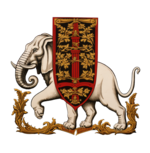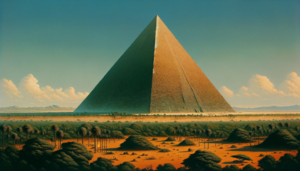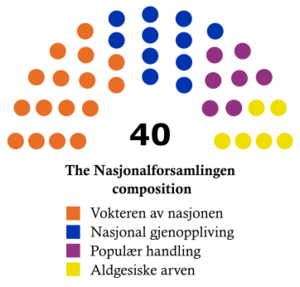Bule
| Bule Republic Folkeveldet Bule | |
| Flag | Coat of arms |
|---|---|

|

|
| Motto: "Å bevare den gyldne horisonten av velstand" - "Preserving the golden horizon of prosperity" | |
| Anthem: Kor av nybyggere - Chorus of the settlers | |
| Locator map | |

| |
| Capital city | Solbergstad |
| Largest city | Norlingstad |
| Official language | Aldsegja |
| Other languages | Aedelish Patois and Native languages |
| Ethnic group | Aldsay - Awawatu |
| Religion | Orkanan - Naskel |
| Demonym(s) | Bubale, Adalu |
| Government | |
| Government Type | Unitary Republic |
| President | Lars Bergstrøm |
| Prime Minister | Henrik Nordahl |
| Legislature | Senate of Bule |
| Establishment | |
| Declaration of Independence | tbc |
| Area | |
| Total | 5,004,823.07 km2 km2 |
| Population | |
| Total | 74,159,966.77 |
| Density | 14.82/km2 |
| Economy | |
| Economy type | Capitalist |
| GDP (total) | Ꞡ 381,330,549,154 |
| GDP per capita | Ꞡ 5,142 |
| Currency | Bule Skilling (skilling-bule.png) |
| Inequality index | 25.5 |
| Development index | 0.875 |
| Other information | |
| Time zone | tbc |
| Driving side | right |
| Calling code | tbc |
| Internet code | .bl |
Bule, officially the Bule Republic (Aedelish: Folkeveldet Bule), is a country located in Tzeraka.
History
Antiquity

The Aladian civilization, an ancient and enigmatic society, left an indelible mark on history with its grandeur, complexity, and cultural distinctiveness. Its ancient homeland nestled in the Ovestan Bay around the Lephoo Delta region on the continent of Tzeraka, the Aladian civilization was a realm of wonders and intricacies that fascinated explorers and scholars alike.
The Aladian civilization thrived for millennia, its origins lost in the mists of time. While the peak of Aladian power and influence is estimated to have occurred approximately five centuries before the arrival of Simal outsiders, the legacy of this civilization endured for generations. It was Captain George Blackstone's encounter with the Byrizi or Aladians as he called them in 7278 that provided the outside world with a glimpse into the grandeur and complexity of their society.
One of the most striking aspects of the Aladian civilization was its architectural prowess. The tuins of the city of Utur, in particular, stood as a testament to their engineering and artistic achievements. Its megalithic palaces, temples and great pyramids of Siri, showcased the Aladians' mastery of construction and design.

The Aladian society was marked by a unique social hierarchy. At its zenith was a small ruling caste, comprising priests and courtesans. They held sway over the fate of the nation and guided its destiny. The majority of Aladians belonged to the vast class of commoners, responsible for upholding the daily functioning of the civilization. At the lowest rung were the Awawatu slaves, referred to as the Qara, who toiled under the rule of the Aladian elite.
To maintain control and order, the elite employed intricate governance systems. Polygyny was a common practice, enabling elite men to take multiple wives, often from lower social strata. The management of offspring from the commoners and Qara involved practices like culling and castration, aimed at maintaining specific sex ratios. In their pursuit of civil harmony among the lower castes, the Aladian society even sanctioned state-sponsored prostitution. These measures, though unusual by external standards, played a vital role in the maintenance of a complex social order.
The cause behind the collapse of the Aladian civilization remains shrouded in mystery. What is known is that the once-thriving delta region, once the heartland of Aladian sophistication, descended into a state of barbarism. The Aladians, a people who had once left an indelible mark on the region, seemed to vanish from the annals of history, leaving behind only faint echoes. In their wake, meager city-states and chiefdoms emerged to fill the void, their modest existence a stark contrast to the grandeur of their predecessors. Over the centuries, any traces of the Aladians and their once-magnificent civilization were gradually devoured by the unrelenting forces of soil, sand, and mud, concealing their fate in the very fabric of the land they once called home
Simal Island Traders Influence (6500s - 7230)
In antiquity, the coastal and delta regions of Bule were intimately entwined with the Simal Island traders, a seafaring civilization renowned for their mastery of the waves. These coastal areas became vital crossroads of commerce and culture, primarily due to their extensive interactions with the Simal traders. The rest of the Bule region, however, was quite different, dominated by small pastoral chiefdoms and petty kingdoms.
The Simal traders established thriving coastal settlements along the Bule coast, fostering vibrant exchanges of goods and knowledge with the indigenous peoples of Tzeraka. This coastal interaction allowed for the introduction of exotic goods and beasts, transported from the heart of Bule, to the bustling trade hubs where Simal and Bule cultures converged.
The impact of the Simal Island traders on Bule's coastal architecture, art, and societal norms was profound, leaving an indelible imprint on the local way of life. The coastal regions flourished as bustling hubs of trade, while the interior retained its distinct character, marked by a patchwork of small pastoral chiefdoms and petty kingdoms, largely untouched by the Simal influence.
The Simal Interregnum Civil War, however, disrupted this once-thriving coastal trade and severed the cultural ties between the coastal and interior regions, ultimately leading to the decline of the Simal influence in Bule.
Aldsegian arrival at the Lephoo Delta (7400s)
In the year 7405, colonial ventures from North Anaria set sail in earnest, each seeking new lands and opportunities. Among these expeditions, the bold and audacious expeditionary force of the Sørtarnland Company emerged as a significant player, setting its sights on the sprawling Lephoo Delta. This delta, a formidable and intricate coastal landscape characterized by tidal flats, mangroves, and verdant islands, held the allure of uncharted territories and untapped potential. Little did they know that it would mark the beginning of a transformative era in the region.
Aedeland, situated to the north of Stoldavia, had missed out on the colonization of distant lands such as Altaia and D'Runia, which were more accessible to its southern neighbors. Faced with limited options for expanding its influence and seeking to bolster its own standing, Aedeland recognized the opportunity presented by the collapse of the Simal Islands' hegemony.
The Simal Islands, once a dominant maritime power, had seen their influence wane, and their ability to control the strategic Simal Straits diminished. Aedeland, capitalizing on this shifting balance of power, employed a strategy of gunboat diplomacy to secure passage through the Simal Straits, effectively opening the way for their expeditionary force.
With the invaluable assistance of Simal traders, who had maintained their presence along the coast despite the decline of their maritime empire, the Aldsegians successfully navigated the labyrinthine waterways of the Lephoo Delta. The coastal settlements, once thriving centers of Simal influence, had by this time seen a reduction in their economic and political clout, making them less resistant to Aldsegian encroachment.
The coastal region surrounding the Inner Ovestan Gulf, which the Aldsegians came to know as Sørtarnland, became the focal point of their colonial ambitions. The Aldsegians established a protectorate over this territory, driven by the goals of resource extraction, acquisition of exotic goods, and the advancement of Stoldavia's interests in the region. To oversee these endeavors, a dedicated company was founded, tasked with the administration of the newly acquired lands, the encouragement of merchants, and the facilitation of resource extraction, setting the stage for a significant chapter in the history of Bule.
Exploration of Bule: Regions of Inner Tzeraka
With the establishment of the protectorate in the Lephoo Delta, Aedeland turned its attention to the uncharted regions of inner Tzeraka, driven by the ambitions of explorers seeking notoriety, prestige, and new horizons for their homeland. Among these intrepid adventurers was Erik Norling, would who become synonymous with the daring exploration of inner Tzeraka.
Norling embarked on a remarkable journey, navigating upstream along the winding course of the Umojio River. His mission was twofold: to document the diverse tribes inhabiting the river's banks and to uncover the elusive source of these mighty waters. His expedition, marked by resilience and curiosity, proved to be a source of inspiration for Aedelandic exploration and prestige.
As he ventured deeper into the heart of Tzeraka, he chronicled the exotic variety of native cultures, each with its unique traditions and ways of life. Alongside these human societies, the explorer encountered an array of exotic fauna that captured the imaginations of Aedelanders back home. His detailed accounts painted vivid portraits of the creatures that inhabited these uncharted lands, fueling the fervor for further exploration.
The culmination of his journey lay at the Omunaka Merge, a vast and enigmatic swampland where the Umojio River met its counterpart, the Umnulo. This convergence gave rise to a unique ecosystem teeming with life. Notably, the Omunaka Merge was renowned for being the habitat of the notorious White elephants of Bule, majestic and elusive creatures that had long fascinated naturalists and adventurers alike.
In addition to the white elephants, the swamplands of the Omunaka Merge were home to the MegaloCrocodylus, colossal crocodiles that patrolled the murky waters with ancient and fearsome prowess. The merge also provided refuge to the Naguja gazelles, graceful creatures that navigated the watery expanses with unparalleled agility.
However, the legacy of this intrepid explorer extended beyond his discoveries in the natural world. Along his journey, he left behind a trail of bastard descendants, a glimpse to his obscure yet famously rakish personal life. His encounters with local communities and personal escapades resulted in the birth of many sons along the river's course, a phenomenon that eventually gave rise to numerous family lineages, each proudly claiming direct ancestry to the great Aldgesian explorer.
Sørtarnland Company's Ambitions (7440s)
The Sørtarnland Company, driven by imperial ambitions and the lure of wealth, embarked on an ambitious mission to bring Tzeraka under Aldsegian control. After the Norling expeditions, the company sought to establish an overland route to the distant Phasian, an alluring realm of untold riches and wonders. The Surtarnland Company envisioned the Umojio as a principal water route to create a shortcut for Phasian traders, bypassing the lengthy and perilous journey around the southern coast of Tzeraka.
Despite numerous attempts and significant investment, the overland route proved to be fraught with dangers and exceedingly costly, making it economically unviable. The highly variable Boral climate of the Bishaan Bay posed considerable risks for Phasian traders, discouraging them from seeking it out as a viable trade port. The treacherous terrain, unpredictable weather, and the presence of hostile local tribes made it clear that the overland route was a formidable challenge.
Abandonment of Overland Route and Aldasy Settlement (7470s)
The formidable challenges of taming the rugged interior and the sheer magnitude of the undertaking eventually compelled the Surtarnland Company to abandon their ambitions of an overland route to Phasian in 7472. Instead, they redirected their efforts towards a more profitable endeavor: the burgeoning slave trade that thrived along the coastal regions of Bule.
With this shift in focus, the destiny of Bule took a significant turn as it evolved into a notorious center for the transcontinental slave trade, reshaping the region's culture, economy, and social fabric. Beneath the surface, the echoes of the ancient Simal Island traders' influence remained.
The change in the company's focus and the opening of lands as far as the Musi River Plains, previously intended for the abandoned overland route, caused an influx of Aldsay settlers from Aedeland. The company sold land tracts to settlers seeking to transform the steep terrain into a fertile grain breadbasket.
These settlers faced native resistance but had the advantage of more advanced rifles and superior organization. They also utilized local natives as indentured workers in their grain plantations and vast cattle ranches. This influx of settlers and the shift towards plantation agriculture further altered the socio-cultural landscape of Bule, as Aldsay traditions and customs began to blend with the indigenous cultures of the region.
Bule Republics Era
The Bule Republics of Antikken and Nambatu were established as two distinct republics following the integration of the Sørtarnland Company holdings into the Aldsegian Empire. These republics, while officially part of the empire, had unique characteristics and roles within the broader colonial landscape.
Antikken, located in the region focused along segments of the Umojio and Lephoo delta, primarily represented the interests of the Aldsay settlers and the Byrizi populations. Over the years, the Byrizi communities in Antikken gradually integrated and became absorbed into the Aldsay majority. This integration was a testament to the low Aldsay settler demographics of Antikken, where the Aldsay sought to bolster their demographics by absorbing peoples they saw as close to the Anarians.
In contrast, Nambatu was conceived as a nominal republic, ostensibly created to represent the native elite and their interests. However, the reality of Nambatu's governance was quite different. The administration of Nambatu was entirely overseen by Aedelish civil servants, and the president of Nambatu effectively served as the governor of Bule. While Nambatu existed on paper, it had little tangible impact on the lives of its citizens, particularly the native Awawatu population.
Aedeland coup 7581
The end of the Pan-Anarian War in 7562 brought about a profound shift in the destiny of Bule. The horrors uncovered in Dhonowlgos ignited a wave of emancipation movements and legislative actions across the Anarian sphere of influence. This global awakening spelled the demise of the transcontinental slave trade, dealing a heavy blow to the Bule economy.
Initially, the abolition of slavery had adverse effects on the Bule Republics, as their economic prosperity had been closely tied to the institution of slavery. However, an unexpected turn of events came in the form of increased grain prices resulting from the widespread reconstruction efforts that followed the Pan-Anarian War. This windfall bolstered the coffers of the Bule Republics of Antikken and Nambatu.
The Bule Republics continued as Aldsegian colonies until the Aedeland Coup of 7581, which resulted in a dramatic change of government and led to a war with Vittmark and other regional powers in northern Anaria. This conflict severed Aedeland from its overseas possessions, effectively marking the end of the Aldsegian Empire.
In the aftermath of these events, the Bule Republics found themselves at a crossroads. They resisted efforts to be absorbed as colonies by Auresia or Vittmark and instead forged an independent future. The settler republic of Antikken assumed the administration of the Aldsegian Tzerakan territories and incorporated the weak and paper-thin republic of Nambatu into the new Bule Republic.
For the next eight decades, the Bule Republic enjoyed widespread acceptance in Anarian circles and emerged as a prominent exporter of grain and raw resources to the Anarian world. Despite its golden post-colonial era, the nation faced a significant challenge in its demographics. A small settler population of less than a million ruled over millions of disfranchised native Awawatu peoples. The nation's settler minority prospered at the expense of the native population, exacerbating the social divide.
The low settler population, coupled with Aldasy-first attitudes, discouraged large-scale migration into Bule. This situation hindered the nation's economic development and the realization of the vast potential resources within its borders. As the world continued to change, Bule faced the dual challenges of economic underperformance and the refusal to address the disparities between its settler and native populations that caused neverending native insurrection.
Isolation era (7640s)
With the establishment of the International Coalition of Nations (ICoN) following the First Coalition War, a significant shift in global consciousness began to take shape. Colonial ideologies and the subjugation of native populations were increasingly questioned and deemed incompatible with the principles of equality and justice that ICoN actively promoted on the world stage. Nowhere was this transformation more evident than in the distant land of Bule, a place where old colonial attitudes clashed with the emerging ideals of a more just world.
Bule, a nation dominated by a small, yet influential ethnic group known as the Adalu, stood in stark contrast to the evolving global norms. The Adalu once known as Aldgesian settlers, were resolute in their desire to maintain their hegemony over the vast lands of Bule. Despite the winds of change blowing across the globe, Bule remained resistant to calls for equality under the law, particularly in its treatment of the native Awawatu population.

As the world gradually closed its doors to Bule due to its increasingly unacceptable treatment of the Awawatu natives, the nation found itself isolated on the global stage. Its unyielding attitudes not only raised eyebrows but also sparked outrage among socialist and orderist nations, which began funding pressure groups both within and outside Bule.
The response to these injustices was a three-decade-long period of armed insurrection that would forever alter the course of Bule's history. Prominent among these resistance movements was the Nambatu Renewal Force (NRF), a formidable armed group dedicated to the establishment of a socialist federal republic that would recognize the rights and aspirations of all native ethnic groups. Drawing inspiration from the concept of Nambatu as a symbol of renewed strength and unity for the Awawatu peoples, the NRF fought relentlessly against the Adalu-dominated government.
Simultaneously, the Orderist League of Awawatuland (OLoA) emerged as a prominent orderist insurrection within Bule. The OLoA was driven by the vision of establishing a pure orderist state, receiving substantial support from orderist powers abroad.
However, while both the NRF and OLoA shared a common goal of challenging the oppressive government, they were far from a united front. The struggle for control of territory and influence led to occasional skirmishes between these two groups, highlighting the complex landscape of resistance in Bule.
Era of alternatives and resilience (7660s to present)
Amidst the turbulent times following the Second Coalition War, an unlikely savior emerged for the beleaguered nation of Bule. Hergom Ep Swekorwos, a nation not often associated with benevolence, extended a helping hand to Bule when it needed it most. However, the roots of this unexpected alliance could be traced back to the war itself, where behind-the-scenes negotiations and promises laid the foundation for a future relationship.
During the Second Coalition War, Hergom had secretly convinced Bule to remain neutral in the conflict, offering tantalizing promises of future benefits. Despite Hergom's somewhat dubious reputation, the isolated and slowly crumbling Bule reluctantly agreed to its suggestions. Despite suspecting that after the war's conclusion, Hergom might have set its sights on Bule as its next target. However, the unforeseen events of the Molotok detonations and the war's conclusion altered the course of history in unexpected ways.
With its newfound position as a neighbor of Bule, Hergom wasted no time in fulfilling its promises to the beleaguered nation. Bule received a rejuvenating influx of surplus military supplies from Hergom, left over from the war. This assistance proved crucial, allowing the numerically inferior Adalu army to gain the upper hand in its struggle against the NRF and OLoA insurgents. While the exact details remain shrouded in secrecy, it is speculated that the Adalu may have allowed Wolgos special forces to lend their expertise in quelling the insurgency.
The pacification of Bule, aided by Hergom, was marked by overwhelming and decisive force. There was no room for negotiation or tolerance for resistance, a stark indication of Wolgos involvement. Sparse reports from adventurous individuals who managed to leave Bule suggested a campaign characterized by indiscriminate destruction and harsh retribution against rebels and civilians who supported them.
In the wake of these pacification campaigns, Bule underwent a transformation. Its previously liberal Adalu-centric government took on a more authoritarian character. Press and telecommunications were nationalized, and censorship tightened its grip across the nation. While the Adalu themselves remained largely unaffected by these changes, as they often benefited from them, the democratic institutions of the republic suffered. The once-vibrant Senate became little more than a gathering place for four dominant parties with now homogenized ideologies, all sharing power in a climate of increasing conformity.
Collaborative infrastructure projects, funded in conjunction with Hergom, reshaped Bule's landscape. A robust communication and transport backbone connecting Bule and Hergom ushered in a shift in Bule's economic focus and trade dynamics. The majority of Bule's exported goods now flowed southward to Hergom, feeding the voracious appetite of Hergom's industries. In return, Bule's industrial development found synergy with the Wolgos Common Market, creating a mutually beneficial relationship that transformed the nation's economic landscape.
Geography
Politics


The Bule Republic operates as a unitary semi-presidential republic, currently led by President Lars Bergstrøm, who is now in his second term. The nation's domestic affairs and economic policy fall under the purview of Prime Minister Henrik Nordahl. President Bergstrøm represents the Vokteren av nasjonen (Vanguard of the Nation) party, while Prime Minister Nordahl hails from the Nasjonal gjenoppliving (National Revival) party. The cabinet comprises ministers from both the Populær handling (Popular Action) and the Aldgesiske arven (Aldgesian Heritage) parties.
As part of the power-sharing agreement established in 7668, the president is selected from the party with the most votes, the prime minister from the second-largest party, and the cabinet must always include representatives from the remaining two parties. Since 7668, the registration of new political parties requires approval through a Senate (Nasjonalforsamlingen) vote, and thus far, no new party has succeeded in registering.
All governing parties in Bule lean toward the center-right to extreme right of the political spectrum. The Aldgesiske arven party is the most right-leaning, while Populær handling takes a more centrist approach, focusing on labor rights and the living standards of the Adalu population. Vokteren av nasjonen prioritizes the preservation of the nation and its independence, advocating for armed isolation. In contrast, the National Revival party seeks to promote the nation's interests through a more assertive international policy.
There exists an illegal and prominent political party known as Nye horisonter, headquartered in Parthenia but with a presence and some support within Bule. This modern left-leaning party advocates for Bule's autonomy and a conciliatory approach toward the native populations of Bule. Nye horisonter criticizes Bule's dependency on Hergom and expresses concerns about the implications of their relationship, they content that in reality to the Wolgos the Adalu are basically the Eokoesr which they hold so much contempt for. Politicians affiliated with Nye horisonter often face blackmail, discreet intimidation attempts, and even assassinations sponsored by Bule and their allies.

Suffrage
In the Bule Republic, voting suffrage is indeed limited, and only citizens with Adalu heritage enjoy full voting rights, while the Awawatu and other native ethnic groups have no voting rights. Despite international criticism and calls for reform from the illegal political party Nye horisonter, the government and its Wolgos allies have shown little inclination to change the existing voting suffrage system. This system continues to exclude the majority of the population, particularly the Awawatu and other native ethnic groups, from participating in the political process. The government's lack of response to international criticism suggests a commitment to maintaining the status quo and preserving the dominance of the Adalu population in the country's political affairs.
Military

Bule Republics' Military Force - Værstyrke
The military force of the Bule Republics is a distinct entity shaped by the region's unique history and needs. Comprising approximately 40,000 service members, this force is designed to address specific challenges encountered within the Bule Republics' borders. The Bule Republics' military is composed entirely of Adalu personnel, with recruitment and service limited to this dominant ethnic group. This exclusivity ensures a sense of cultural cohesion and unity within the military ranks.
The Bule military is organized into specialized units, including infantry, armored divisions, and an air wing. It maintains a well-defined chain of command led by experienced officers responsible for leading their units. In addition to conventional forces, the military includes specialized units like the Bule Republics' Commandos, tasked with covert operations and counterinsurgency missions.
Many aspects of the military's structure and organization harken back to the old Aldgesian Empire, where hierarchical structures and disciplined formations were highly valued. This legacy is evident in the military's chain of command, divisional organization, and ceremonial practices.
Self-reliance and Equipment Production
The Bule Republics prioritize self-reliance when it comes to basic equipment and ammunition. The nation has developed local manufacturing capabilities to produce essential supplies, ensuring operational independence and resilience even when external supply lines face disruption.
While the Bule military remains self-sufficient for fundamental equipment, it collaborates closely with neighboring Wolgos for access to advanced weaponry and technology. Wolgos serves as a vital ally, offering the Bule Republics military support, intelligence sharing, and training, bolstering its overall capabilities.
The Bule Republics maintain a modest navy responsible for safeguarding its narrow coastline in the delta region. This navy's primary role is to prevent amphibious invasions and patrol the intricate network of waterways, ensuring the security of critical coastal areas.
Airforce
The Bule Republics' Air Force represents a significant leap forward in terms of modernization. With a primary focus on transport, support, and the potential for air superiority, this branch of the military has seen substantial investment and expansion.
The Bule Republics' Air Force plays a critical role in the nation's military strategy. Given the vast territory and challenging geography of the Bule region, air transportation has become indispensable for swiftly moving forces across long distances.
Recognizing the importance of air power in modern warfare, the Bule Republics have invested significantly in the expansion and enhancement of their Air Force. This includes the acquisition of various aircraft types and technologies to bolster their capabilities.
The aircraft used by the Bule Republics' Air Force are exclusively variations of Wolgos designs. This partnership with neighboring Wolgos ensures access to advanced technology and expertise, allowing the Air Force to maintain a high level of operational readiness.
While currently focused on transport and support functions, the Bule Republics are gradually building up their Air Force's capacity to project air superiority. This capability serves as a deterrent against potential invaders and bolsters the nation's overall defense strategy.
Economy
As part of the Ombhrosdhom Commonwealth Treaty, Bule has aligned its commerce, agriculture and industry to that of Hergom ep Swekorwos. Bule's agriculture is part of the United Agricultural Policy and specialises in crops that are best suited to its territory and the needs of the Commonwealth as a whole. Bule is a major grain and flour provider to underdeveloped Tzeraka nations and with support from Hergom its mechanisation and yields have increased to support sizable exports. Bule is the only wine producer for the whole Commonwealth and its major citrus producer.
Bule has a modest industrial sector which has grown in efficiency as it no longer has to support an autarky economy. Its industry no longer has to fill every niche and now has specialised to meet the nation's construction, energy, agricultural and consumer goods. Its increase in efficiency has allowed it to become an exporter of consumer foodstuffs and luxury items such as wine, furniture, marble and others to Hergom and the Commonwealth. Bule now relies on Hergom for telecommunications equipment, heavy machinery, military equipment and high technology.
Demographics
The Bule Republics stand as a testament to their rich tapestry of diversity, where various ethnic groups have interwoven their traditions and histories over the years. Among the native population of Bule, Awawatu peoples hold the majority, accounting for a significant 70%. Within this diverse group, the Sungalu people represent the largest portion, with their distinct customs and cultural heritage. Alongside the Sungalu, you'll find the Laleela, Ogonoro, Biajuko, Agba, Uocha, and Ilebije ethnic groups, each contributing their unique flavors to the vibrant mosaic of Awawatu culture.
Utura, a distinct ethnic group hailing from the southern regions of Tzeraka, comprise approximately 10% of the native population. The Utura people include the Numatenu, Mumuta, and Abila ethnic groups, each with its own set of traditions and practices that have been passed down through generations.
The Adalu, often colloquially referred to as the Bubale, constitute another significant portion, making up around 15% of the population. They are a fascinating amalgamation of various Anarian ethnic groups, primarily the Aldsay, Cheltai, Karst, and Dolmer. These Adalu individuals have predominantly settled in the river regions and economic hubs of Bule, where they have melded their unique backgrounds into a vibrant, cohesive identity. A large Adalu minority possess traces of Byrizi ancestry, concentrated particularly in the delta region. Additionally, within the Adalu community, you'll find those who have intermixed with the Awawatu, often resulting in individuals considered closer to the Aldsay or Anarian ideal. These individuals typically have less than a quarter Awawatu heritage.
Lastly, the Nyesu, constituting about 5% of the population, represent a group with roots in both Adalu and Awawatu ancestry. They often find themselves at the intersection of these two communities, their heritage serving as a bridge between distinct cultures. Those of Nyesu descent, not fully accepted into the Adalu community, frequently have half or more Awawatu heritage.
| Typical Adalu or Bubale | ||
|---|---|---|

|

|

|
| North Anarian Adalu | Adalu with Awawatu heritage | Adalu with Birizy heritage |

|

|
|
| Typical Awawatu | Nyesu | |
Culture
- See also: Old Aladu Culture
Adalu culture, rooted in its Adelish origins, has uniquely evolved over centuries, integrating settlers' experiences and economic development. This evolution has created a distinctive culture, rich in pastoral heritage and rancher traditions, with a deep connection to the ancient Aladian civilization of the Ovestan coast.
At the core of Adalu culture is a strong pastoral heritage. The lifestyle and practices surrounding cattle ranching have become intrinsic to the Adalu identity. Horse riding and rancher culture, encompassing all aspects of cattle management, are not just economic activities but deeply embedded social customs.
The Adalu have embraced the legacy of the ancient Aladian civilization, whose remnants were assimilated into the Adalu ethnicity. This has led to a revival of Aladian arts and architecture, with the Adalu revering arcane symbols and styles from this ancient era. The Aladian civilization serves as a significant source of inspiration, as the Adalu endeavor to find and celebrate parallels between their Aedelish and Aladian heritages.
Language
Aldsegja, the official language of Aedeland and a cornerstone of its culture, also holds a special place in Adalu society. Though its roots are in Aedeland, Aldsegja's use in Adalu has become a symbol of cultural preservation and identity. Despite its formal nature and ties to Aedeland, it remains a unifying element in Adalu's diverse society.
Religion
In Adalu, the predominant religious belief is the Orkanan sect known as Salvede Trúba, adhered to by over 60% of the population. This sect encompasses two main perspectives: the Transcendentalists, who view material existence as corrupting, and the Materialists, who see the physical world as a divine expression. This religious dichotomy deeply influences Adalu's cultural and daily life. 'Salvede Trúba' is also the dominant Orkanan sect in Aedeland.
Ætt System and society
The Ætt system, a legacy of the old Aldgesian empire, continues to play a crucial role in Adalu society. These kin groups, each comprising about three thousand members, operate as small communities led by councils of Ældermenn. They collectively manage vast agricultural and grazing lands, reinforcing a sense of community and shared responsibility.
Reflecting its Aldgesian heritage, Adalu's educational system remains gender-specific. Boys and girls receive joint education until adolescence, after which they follow separate paths. Boys are prepared for military and leadership roles, while girls are guided towards domestic responsibilities, a tradition emphasizing established gender roles in Adalu society.
Adalu society maintains a strict etiquette code, particularly regarding gender and class interactions. Men enjoy more social freedom, while women and children are subject to more regulations. The culture accords high respect to elders, reflected in practices like standing for elders and using appropriate honorifics.
Cuisine
Adalu cuisine, though mirroring its Aedelish counterpart in many ways, has its unique characteristics. A variety of cured, smoked, and fermented foods, including numerous sausage varieties, are staples. Unlike Aedeland, seafood is less common, with river and lake fish being more popular. Influences from old Aladian cuisine are evident in the use of lettuce and lettuce seed oil, cumin, turmeric, and chickpeas, creating a distinct culinary identity.
Awawatu Culture

In the diverse cultural landscape of Bule, the Awawatu community, often overlooked, possesses a rich and vibrant heritage. Their culture, deeply rooted in the Naskel faith and indigenous beliefs, paints a picture of a people profoundly connected to their traditions and the natural world.
Symbols of Wealth and Identity Central to Awawatu culture is the reverence for cattle and goats. These animals are not merely livestock; they are sacred, symbolizing wealth and social status. This reverence is deeply ingrained, with the Awawatu meticulously caring for these animals, reflecting their respect for nature and its gifts.
A reflection of art and nature: the Awawatu are known for their exquisite woolen tunics, intricately woven and dyed using natural substances. The deep burgundy hue, a signature of Awawatu attire, is derived from local berries, a testament to their resourcefulness and connection with the land. These tunics are not just clothing; they are artworks, embodying the cultural identity and craftsmanship of the Awawatu people. A craft of status and life stages in Bule, the Awawatu's craftsmanship is further exemplified in their creation of bone beads. These beads, polished to a brilliant white and sun-bleached, are crafted into long, flowing neckbands and pendants. Each piece is a narrative, symbolizing the wearer's social status and their journey through life's stages. These adornments are not mere accessories; they are integral to Awawatu identity and heritage.
A blend of nourishment and ritual: the Awawatu diet is a fusion of sustenance and ritual. Milk, meat stews, and blood form the cornerstone of their cuisine, highlighting their pastoral lifestyle. These elements are not just consumed for nourishment but are part of larger cultural and religious practices. Carbohydrates are primarily sourced from root vegetables and Nujur acacia grains, demonstrating their reliance on and harmony with the natural environment.
Foreign Relations
Bule's domestic politics are marked by an isolationist stance advocated by the Vokteren av nasjonen (Vanguard of the Nation) party, which aims to preserve the nation's sovereignty and maintain armed isolation from external influences. This stance has shaped Bule's international relationships by keeping it somewhat aloof from broader geopolitical affairs.
The cornerstone of Bule's international relationships is its alliance with Hergom, a neighboring nation. This alliance was initiated during the Second Coalition War, when Hergom offered Bule strategic support and aid. This alliance has been mutually beneficial, with Bule providing agricultural and mineral resources to Hergom, further strengthening their partnership. Despite being beneficial the Alliance has created a deep dependance on Hergom and not Bule's foreign policy is subservient to Hergom's
Bule's diplomatic efforts have been somewhat limited, focusing primarily on maintaining its relationship with Hergom and safeguarding its domestic interests. It has been reluctant to engage in broader international initiatives or forge new alliances.